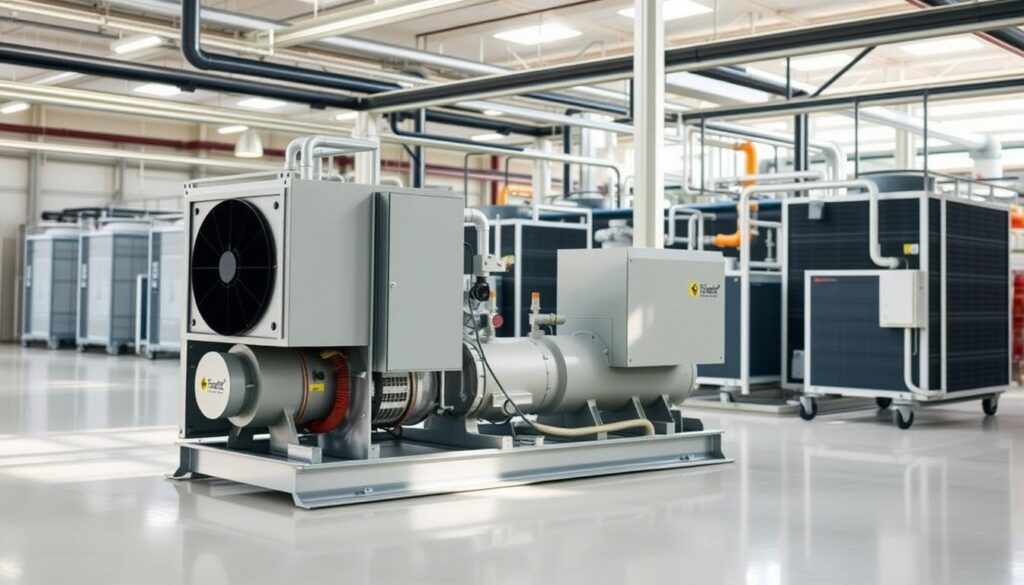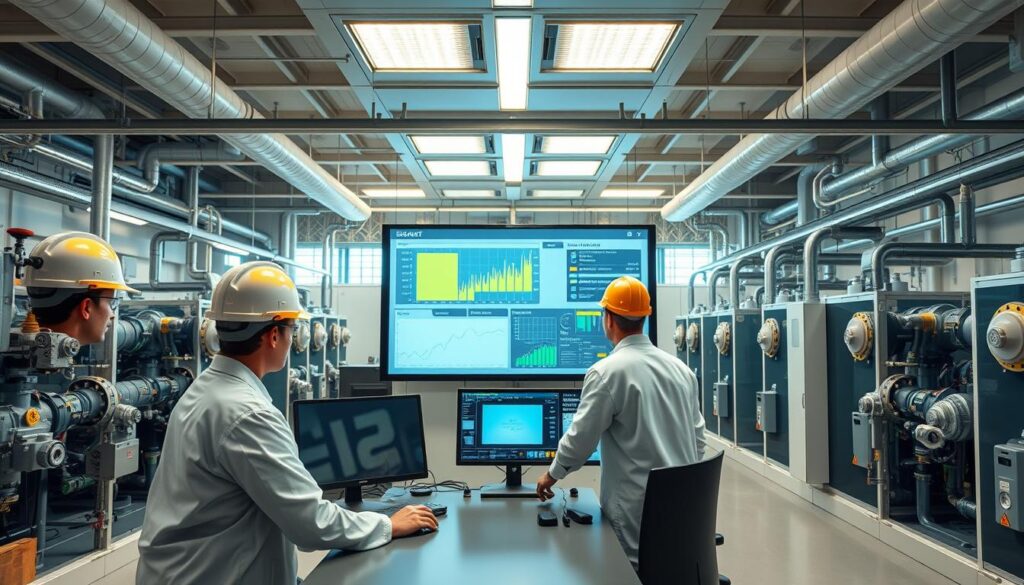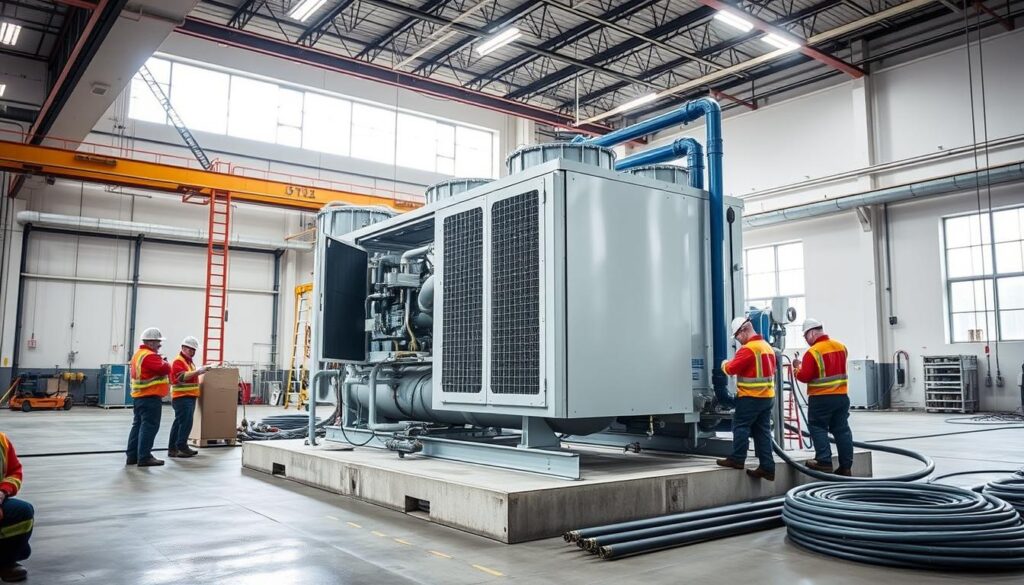Affiliate Disclosure
HVAC Guide Guys is a participant in the Amazon Services LLC Associates Program, an affiliate advertising program designed to provide a means for sites to earn advertising fees by advertising and linking to Amazon.
What Are Chillers in HVAC? Ever wondered how big buildings stay cool in the summer? It’s thanks to HVAC chiller systems. These systems keep the inside cool without making a sound.

Chillers in HVAC are complex machines. They take heat out of liquid using special cooling cycles. These systems are key for cooling big places like offices, hospitals, and factories in the U.S.
Learning about chillers shows how important they are in keeping us cool. They work like heat exchange machines. They change liquid temperatures to make indoor spaces comfortable.
Key Takeaways
- Chillers are key cooling devices in HVAC systems
- They remove heat through advanced cooling processes
- Essential for keeping temperatures steady in large areas
- Used in commercial, industrial, and home settings
- Advanced heat exchange technology
Table of Contents
Understanding What Are Chillers in HVAC
Chillers are key in modern air conditioning systems. They control temperatures in commercial and industrial buildings. These machines keep indoor spaces comfortable and consistent.
To understand chillers, we need to look at their main function. Chillers work through a complex refrigeration cycle. This cycle efficiently takes heat out of water or other cooling mediums.
Basic Principles of Chiller Operation
The main steps of chiller operation are:
- They absorb heat from the building’s environment.
- Refrigerant flows through special parts.
- They lower the temperature of the cooling medium.
- Chilled water is then spread across the facility.
Role in Commercial Building Cooling
Commercial buildings need chillers for temperature control. They cool:
- Office spaces
- Data centers
- Manufacturing facilities
- Large retail areas
Energy Consumption and Efficiency Overview
Today’s chillers focus on saving energy. Industrial chiller efficiency is a big deal for cost and environmental savings.
With new tech and smart controls, chillers now use less energy. They keep cooling performance high while cutting down on energy use.
Explore Our HVAC Shop
Looking for top-rated HVAC tools, parts, and accessories? Visit our shop and find the perfect solution for your needs.
Visit the ShopCore Components of Modern Chiller Systems
It’s important to know the main parts of HVAC chiller systems. They have four key parts that work together. This makes cooling systems efficient for big buildings.
- Evaporator: Absorbs heat from the cooling system
- Compressor: Circulates and pressurizes refrigerant
- Condenser: Releases absorbed heat to the external environment
- Expansion Valve: Regulates refrigerant flow and pressure
Each part is vital in the cooling process. The evaporator is where warm water meets the refrigerant. This is key for cooling.
| Component | Primary Function | Key Characteristic |
|---|---|---|
| Evaporator | Heat Absorption | Cools Water Through Refrigerant Exchange |
| Compressor | Refrigerant Circulation | Increases Refrigerant Pressure |
| Condenser | Heat Rejection | Releases Absorbed Heat |
| Expansion Valve | Refrigerant Flow Control | Manages Pressure and Temperature |
“The efficiency of a chiller system depends on the seamless interaction between its core components.” – HVAC Engineering Experts
Knowing these parts helps us see the advanced tech in cooling systems. Each part is essential for a reliable cooling cycle. This meets many cooling needs.
The Refrigeration Cycle in HVAC Chillers
Knowing about the hvac refrigeration cycle is key for those in commercial HVAC chiller maintenance. It’s a complex process that changes refrigerant from liquid to gas and back. This change helps cool buildings efficiently and keeps them comfortable.
The refrigeration cycle has four main stages. These stages work together to cool indoor spaces:
- Absorbing thermal energy
- Transferring heat effectively
- Maintaining consistent cooling performance
- Ensuring system efficiency
Evaporation Process
In evaporation, refrigerant takes in heat from around it. Low-pressure liquid refrigerant turns into gas in the evaporator. This process cools the space.
Compression Stage
The compression stage heats and presses the refrigerant. A compressor makes the gas hotter and more pressurized. This gets it ready for the next step.
Condensation Phase
In condensation, the hot gas releases its heat outside. As it cools, it turns back into liquid. This is a key part of cooling.
Expansion Valve Function
The expansion valve controls refrigerant flow, lowering its pressure and temperature. It’s vital for starting the cooling cycle again. This keeps the system running well.
Types of Water-Cooled Chiller Systems
Water-cooled chillers are a top choice for cooling in commercial and industrial settings. They use water to cool, which makes them very effective. Knowing the different types can help you choose the right one for your needs.
There are several main types of water-cooled chillers, each with its own strengths:
- Centrifugal Childers: Great for big cooling jobs with lots of demand
- Screw Compressor Childers: Good for medium to large buildings
- Scroll Compressor Childers: Best for smaller spaces
Water-cooled chillers often beat air-cooled systems in efficiency and cost. They have big advantages:
- Better heat transfer
- Consistent performance in different temperatures
- Longer life for the equipment
Choosing the right chiller depends on several things like building size and cooling needs. HVAC experts can guide you to the best water-cooled chiller for your project.
Explore Our HVAC Shop
Looking for top-rated HVAC tools, parts, and accessories? Visit our shop and find the perfect solution for your needs.
Visit the ShopAir-Cooled Chiller Technologies
Air-cooled chillers are key in industrial cooling systems. They use ambient air to cool refrigerant. This makes them great for many environments.
Knowing the difference between water cooled and air cooled chillers is important. Air-cooled chillers have special benefits. They are perfect for certain cooling needs.
Advantages and Applications
- Ideal for smaller to medium-sized installations
- Minimal water consumption requirements
- Lower initial installation costs
- Flexible placement options
- Reduced maintenance complexity
Critical Performance Considerations
When looking at chiller efficiency, several factors matter:
- Ambient temperature ranges
- Thermal transfer capabilities
- Compressor technology
- Airflow design
- Heat exchanger efficiency
Advanced Technology Insights
Modern air-cooled chillers have advanced designs. Technological innovations have boosted cooling and energy efficiency. They now compete with water-cooled chillers.
The evolution of air-cooled chiller technologies continues to push the boundaries of industrial cooling efficiency.
Chiller Plant Operation and Management

Managing hvac chiller systems needs careful planning and precise techniques. Your chiller plant’s performance affects energy use and building comfort. Knowing how to maintain commercial HVAC chillers can make your system last longer and work better.
Key parts of good chiller plant management include:
- Load management and system optimization
- Regular performance monitoring
- Temperature control strategies
- Energy consumption tracking
Using advanced control methods can make your chiller system more efficient. Variable speed drives let you adjust cooling demand, saving energy. Free cooling uses outside temperatures to cut down on mechanical cooling needs.
Good commercial HVAC chiller maintenance means:
- Comprehensive system inspections
- Predictive diagnostic assessments
- Proactive component replacements
- Continuous performance optimization
Facility managers should create detailed maintenance plans to catch problems early. Using smart monitoring and following maintenance guidelines can boost your chiller plant’s efficiency and lifespan.
Energy Optimization Strategies for Chillers
To boost industrial chiller efficiency, a smart energy management plan is needed. Knowing how chillers work in air conditioning systems is key. This knowledge helps in using effective methods to cut costs and boost performance.
Effective energy optimization involves several strategies that can greatly improve your chiller system’s performance. By focusing on key areas, you can save a lot of energy and make your system more efficient.
Performance Monitoring Techniques
Using advanced tools for performance monitoring lets you track important metrics in real-time. These tools help spot inefficiencies and performance issues in your industrial chiller system.
- Utilize digital monitoring platforms
- Track energy consumption patterns
- Implement predictive maintenance protocols
- Analyze temperature and pressure data
Efficiency Improvement Strategies
To boost chiller efficiency, you need a plan that covers all system parts. Your efforts can lead to big energy savings with smart interventions.
- Install variable frequency drives
- Optimize chilled water temperature
- Upgrade control systems
- Implement heat recovery mechanisms
Cost Reduction Methods
Lowering operational costs begins with understanding your air conditioning chiller system. Smart strategies can cut energy use while keeping performance high.
- Regular system maintenance
- Smart control integration
- Energy-efficient component upgrades
- Comprehensive performance audits
By using these energy optimization strategies, you can make your industrial chiller system more efficient and cost-effective. Keeping an eye on performance and managing it proactively is essential for lasting improvements.
Explore Our HVAC Shop
Looking for top-rated HVAC tools, parts, and accessories? Visit our shop and find the perfect solution for your needs.
Visit the ShopInstallation Requirements and Best Practices

Installing an HVAC chiller system needs careful planning and precise execution. It’s key for the system to work well and last long. This is true for commercial HVAC chiller maintenance strategies.
Before you start, think about a few important things:
- Space requirements and equipment positioning
- Proper ventilation and airflow
- Structural support and load-bearing considerations
- Electrical system compatibility
- Piping and connection specifications
When placing your chiller, think strategically. Make sure it has enough room for maintenance and good air flow. The structure must support the system’s weight and any vibrations.
Here are some key steps for installation:
- Do a full site assessment
- Check the electrical load and connections needed
- Get the chiller level and mounted right
- Install insulation and dampeners for vibration
- Do thorough tests before starting up
Getting a pro to install your chiller is vital. It ensures your system works efficiently and avoids future maintenance issues.
Precision in installation determines 70% of a chiller system’s long-term performance and reliability.
Experts say to hire certified HVAC technicians. They know the detailed needs of complex chiller systems. They can guide you through technical details and make sure your installation meets standards.
Maintenance and Troubleshooting Guidelines
Keeping your commercial HVAC chiller in top shape is key. It ensures your system works well and lasts longer. Regular care and watching for problems helps avoid sudden breakdowns and keeps efficiency high.
Using a detailed chiller troubleshooting guide is a smart move. It lets facility managers spot and fix issues early. This way, you avoid big problems and save money on repairs.
Preventive Maintenance Schedule
A good maintenance plan should include:
- Monthly checks on refrigerant levels
- Quarterly cleaning of coils
- Semi-annual checks on electrical connections and controls
- Annual full system check-ups
Common Issues and Solutions
Chiller systems often face a few common problems:
- Refrigerant Leaks: Do pressure tests and fix leaks fast
- Compressor Failures: Watch for unusual vibrations and temperatures
- Control System Malfunctions: Keep software up to date and sensors calibrated
Emergency Response Procedures
Have a plan for quick action when big problems happen. Know who to call, keep emergency numbers handy, and have backup plans ready.
Proactive maintenance is always more cost-effective than reactive repairs.
Explore Our HVAC Shop
Looking for top-rated HVAC tools, parts, and accessories? Visit our shop and find the perfect solution for your needs.
Visit the ShopAdvanced Chiller Technologies and Innovations
The world of HVAC chillers is changing fast with new technologies. Modern chillers are now more efficient and sustainable. They use advanced tech for better performance and smart operation.
New technologies are making chiller systems better in many ways:
- Magnetic Bearing Compressors: These compressors cut down on friction and wear. They make chillers more energy-efficient.
- Smart Diagnostic Systems: Artificial intelligence helps with predictive maintenance and keeps an eye on performance in real-time.
- Low Global Warming Potentia (GWP) Refrigerants: These refrigerants are better for the environment and are a big step forward in technology.
Now, manufacturers are adding smart tech to old cooling methods. These systems can predict problems, save energy, and give deep insights into how they’re working.
The future of industrial chiller efficiency is all about smart, adaptable tech. It’s about being good for the planet and working better.
Some key tech innovations include:
- Machine learning for predicting when things might break
- Advanced sensors for constant monitoring
- Modular designs for easy scaling and flexibility
By using these new technologies, companies can save a lot on energy and maintenance. They also help make HVAC systems more eco-friendly for the future.
Conclusion
Exploring what are chillers in HVAC has given you key insights. You now know how these cooling technologies work. They are vital for managing temperatures in commercial and industrial settings.
Chillers come in different types, like water-cooled and air-cooled. These systems are the core of today’s climate control. They keep places cool and comfortable.
Chiller technology has grown a lot, focusing on energy efficiency and performance. You learned that picking the right chiller is important. It depends on how it works, how much energy it uses, and how easy it is to maintain.
There are always new ways to make chillers better. This means we can expect even more efficient cooling in the future.
Knowing about HVAC chiller systems helps you make better choices. Whether you’re running a big building or setting up cooling systems, it’s key. The latest tech will keep making cooling systems better and more green.
Getting good at HVAC chiller systems means seeing their big role. They help make places cool and save energy. By focusing on performance, upkeep, and new tech, you can improve cooling. This helps with both money and the environment in today’s world.

